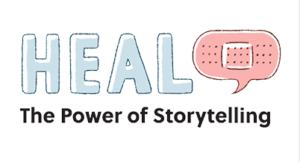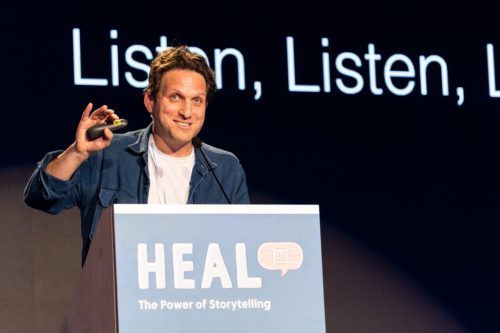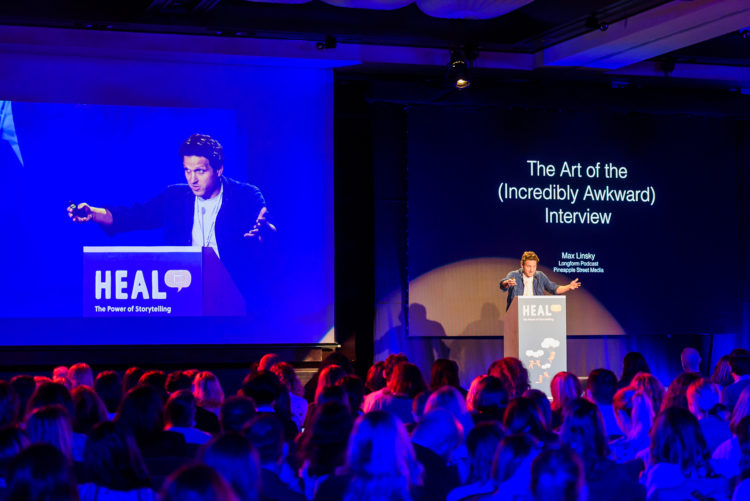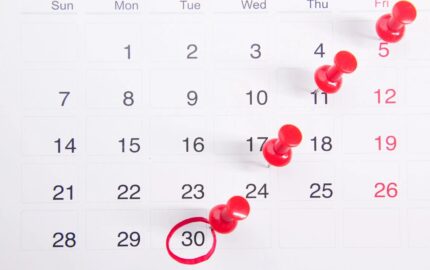In the seven years since Max Linsky co-founded the Longform Podcast (with Evan Ratliff and Aaron Lammer), he has interviewed hundreds of storytelling luminaries: journalists, non-fiction writers and public figures. That includes “Wild” author Cheryl Strayed, author and New Yorker writer David Grann, “This American Life” guru Ira Glass, New Yorker editor David Remnick, film critic Renata Adler, “Fresh Air” host Terry Gross, and Hillary Clinton, with whom he co-hosted the “With Her” podcast.
Through all that, Linsky developed “The Art of the (Incredibly Awkward) Interview,” which he now uses when coaching other audio producers or people new to podcasting who do work through his company Pineapple Street Media, which has produced some of the top shows on iTunes.
 In a charmingly awkward keynote, Linsky shared stories from his fumbling journey to success at the 2019 Power of Storytelling conference in Bucharest. The rules, if we can call them that, are as powerful as they are simple, and apply to any kind of interviewing.
In a charmingly awkward keynote, Linsky shared stories from his fumbling journey to success at the 2019 Power of Storytelling conference in Bucharest. The rules, if we can call them that, are as powerful as they are simple, and apply to any kind of interviewing.
Linsky’s Five Rules for Interviewing
“Audio is a very unforgiving medium to bullshit. You can't fake it. If you don't care, if you're not genuinely curious about the person you're talking to, people can hear it.”
He explained there are hundreds of thousands of podcasts out there, but even the most loyal podcast listeners tune into no more than four or five episodes a week. Podcast storytellers have to figure out how to break through people’s listening habits, and that all starts with caring about their subjects, he said.
“There's a very specific way one should prepare for an interview, which is not to come up with a crazy list of questions, and then sit down in front of someone and read verbatim. I did that for a long time when we started Longform. I would go in with crazy notes, a list of 50 questions. What happens is you're staring at your questions while the person is talking. It's a bad scene.”
Now he goes in with a few index cards and divides the interview into acts.
“For example, I know in the first third I want to talk about where they grew up, second third about a book they wrote or an article, last third maybe is whatever I perceive their great anxiety to be. I want to know where I'm going, but I have no road-map other than that.” This forces him to listen, be present and ask follow-up questions. “I’ve found it's much more effective than walking in with a whole arc of questions. No matter how much you prepare, the person is going to surprise you anyway.”
It seems obvious, but Linsky has found that it’s one of the most important rules of interviewing. "Fresh Air" host Terry Gross actually inspired this rule when she told him how she negotiates with her subjects: “If I ask something that’s too personal, just tell me and I’ll move on.”
“It's brilliant for two reasons: it makes it clear that it's not a gotcha-interview, I'm not bringing you here to get you to say something you don't want to say. But it also says: I'm going to ask you some really personal questions, you should get ready. And I ask a version of that: if I ask you something dumb, that doesn't make sense or you don't have an answer to, instead of talking for 10 minutes and trying to come up with an answer, just say that was one of the dumb questions and we'll move on.”
Remember: It’s not about you. It’s about the person you’re interviewing. And sometimes, to help them open up, you have to be willing to sound like an idiot.
“Your job is to get the best out of them. And a lot of times, the best way to do that is to ask a simple question that's straightforward. There's this overwhelming urge, when you're doing interviews, to do six rounds of context before you get to the question, so everyone knows how smart you are. No one cares how smart you are. They care how smart the other person is.”
This is another one that seems obvious, but is easier said than done.
“The best interviews are the ones where you're present, you're there, you're not looking at your notes, and you’re listening to what people are saying. That's hard, it's a skill you need to develop.”
But if you can combine this rule and the first one – caring – you’re mostly set.
 That’s the method. But what is Linsky trying to achieve with it? What does he want to get out of his guests? What’s the gem he’s probing to find?
That’s the method. But what is Linsky trying to achieve with it? What does he want to get out of his guests? What’s the gem he’s probing to find?
“My goal is to get people to think out loud,” he said. “I want people to be able to get off whatever their ‘talking points’ are. I want people to discover something as they're talking. And if you care, and you listen, and keep pulling the threads of whatever they're putting out, you can’t get them to stop.”
It can get uncomfortable, especially during long silences. Linsky said he dreaded those when he first started podcast interviews, and tried to fill them with prompts like “So what happened?” But he discovered that if you stop and let people think for a bit, they fill the silences themselves.
Ultimately, it’s about creating moments what sticks with people: with him, with the guest, but mostly with the listener. It’s about getting people to come back to the show, Linsky says. And he was surprised to discover that the moments they come back for, and the moments that have delighted him, are the awkward ones. Examples:
He finally landed a long-desired interview with Ira Glass in 2015 — only to feel he blew it. Frustrated with himself, he swallowed his pride and went back for a second try. That’s when he ended up asking Glass about the challenges of being a boss and how they interact with making such great work.
“Those 20 minutes were better than what had come before, because it wasn't just Ira’s radio wisdom. He said all this stuff he hadn't said before or since. So sit in that discomfort and bring it into the room.”
In a podcast episode with David Remnick, there was an awkward moment when Linsky couldn’t figure how to ask him something. Remnick took over and put the question out there for both of them: Do I think about life outside the editor’s chair? Then Remnick answered his own question with surprising honesty.
“It took me stammering and being awkward, but it created a space that he filled with a thing I think he has or had been thinking about, and hadn't been talking about.”
Another challenging interview was with Ariel Levy, shortly after she published “Thanksgiving in Mongolia,” the heartbreaking account of giving birth alone at five months, on the bathroom floor of a hotel in Mongolia, and holding her dying baby. After arranging the interview, Linsky worried that he wouldn’t be able to broach such a tender subject with Levy. But as happened with Remnick, his stammering and hesitation prompted Levy to jump in and deliver what Linsky views as the greatest monologue he has ever heard about courage in writing:
And with George Saunders in an episode in 2014, Linsky overcame a hostile interviewing environment (phones ringing, people barging into the room mid-recording) by jumping to the point and asking Saunders about… what else? The meaning of life. The answer is something Linsky comes back to all the time: “It's incredible life advice, but it's also incredible interviewing advice: Be open to the people you're with. Find connection. Be OK being uncomfortable.”
Through all that, Linsky developed “The Art of the (Incredibly Awkward) Interview,” which he now uses when coaching other audio producers or people new to podcasting who do work through his company Pineapple Street Media, which has produced some of the top shows on iTunes.
 In a charmingly awkward keynote, Linsky shared stories from his fumbling journey to success at the 2019 Power of Storytelling conference in Bucharest. The rules, if we can call them that, are as powerful as they are simple, and apply to any kind of interviewing.
In a charmingly awkward keynote, Linsky shared stories from his fumbling journey to success at the 2019 Power of Storytelling conference in Bucharest. The rules, if we can call them that, are as powerful as they are simple, and apply to any kind of interviewing.Linsky’s Five Rules for Interviewing
- Give a shit.
“Audio is a very unforgiving medium to bullshit. You can't fake it. If you don't care, if you're not genuinely curious about the person you're talking to, people can hear it.”
He explained there are hundreds of thousands of podcasts out there, but even the most loyal podcast listeners tune into no more than four or five episodes a week. Podcast storytellers have to figure out how to break through people’s listening habits, and that all starts with caring about their subjects, he said.
- Be prepared.
“There's a very specific way one should prepare for an interview, which is not to come up with a crazy list of questions, and then sit down in front of someone and read verbatim. I did that for a long time when we started Longform. I would go in with crazy notes, a list of 50 questions. What happens is you're staring at your questions while the person is talking. It's a bad scene.”
Now he goes in with a few index cards and divides the interview into acts.
“For example, I know in the first third I want to talk about where they grew up, second third about a book they wrote or an article, last third maybe is whatever I perceive their great anxiety to be. I want to know where I'm going, but I have no road-map other than that.” This forces him to listen, be present and ask follow-up questions. “I’ve found it's much more effective than walking in with a whole arc of questions. No matter how much you prepare, the person is going to surprise you anyway.”
- Set your ground rules.
It seems obvious, but Linsky has found that it’s one of the most important rules of interviewing. "Fresh Air" host Terry Gross actually inspired this rule when she told him how she negotiates with her subjects: “If I ask something that’s too personal, just tell me and I’ll move on.”
“It's brilliant for two reasons: it makes it clear that it's not a gotcha-interview, I'm not bringing you here to get you to say something you don't want to say. But it also says: I'm going to ask you some really personal questions, you should get ready. And I ask a version of that: if I ask you something dumb, that doesn't make sense or you don't have an answer to, instead of talking for 10 minutes and trying to come up with an answer, just say that was one of the dumb questions and we'll move on.”
- Be game to sound dumb.
Remember: It’s not about you. It’s about the person you’re interviewing. And sometimes, to help them open up, you have to be willing to sound like an idiot.
“Your job is to get the best out of them. And a lot of times, the best way to do that is to ask a simple question that's straightforward. There's this overwhelming urge, when you're doing interviews, to do six rounds of context before you get to the question, so everyone knows how smart you are. No one cares how smart you are. They care how smart the other person is.”
- Listen, listen, listen.
This is another one that seems obvious, but is easier said than done.
“The best interviews are the ones where you're present, you're there, you're not looking at your notes, and you’re listening to what people are saying. That's hard, it's a skill you need to develop.”
But if you can combine this rule and the first one – caring – you’re mostly set.
 That’s the method. But what is Linsky trying to achieve with it? What does he want to get out of his guests? What’s the gem he’s probing to find?
That’s the method. But what is Linsky trying to achieve with it? What does he want to get out of his guests? What’s the gem he’s probing to find?“My goal is to get people to think out loud,” he said. “I want people to be able to get off whatever their ‘talking points’ are. I want people to discover something as they're talking. And if you care, and you listen, and keep pulling the threads of whatever they're putting out, you can’t get them to stop.”
It can get uncomfortable, especially during long silences. Linsky said he dreaded those when he first started podcast interviews, and tried to fill them with prompts like “So what happened?” But he discovered that if you stop and let people think for a bit, they fill the silences themselves.
Ultimately, it’s about creating moments what sticks with people: with him, with the guest, but mostly with the listener. It’s about getting people to come back to the show, Linsky says. And he was surprised to discover that the moments they come back for, and the moments that have delighted him, are the awkward ones. Examples:
He finally landed a long-desired interview with Ira Glass in 2015 — only to feel he blew it. Frustrated with himself, he swallowed his pride and went back for a second try. That’s when he ended up asking Glass about the challenges of being a boss and how they interact with making such great work.
“Those 20 minutes were better than what had come before, because it wasn't just Ira’s radio wisdom. He said all this stuff he hadn't said before or since. So sit in that discomfort and bring it into the room.”
In a podcast episode with David Remnick, there was an awkward moment when Linsky couldn’t figure how to ask him something. Remnick took over and put the question out there for both of them: Do I think about life outside the editor’s chair? Then Remnick answered his own question with surprising honesty.
“It took me stammering and being awkward, but it created a space that he filled with a thing I think he has or had been thinking about, and hadn't been talking about.”
Another challenging interview was with Ariel Levy, shortly after she published “Thanksgiving in Mongolia,” the heartbreaking account of giving birth alone at five months, on the bathroom floor of a hotel in Mongolia, and holding her dying baby. After arranging the interview, Linsky worried that he wouldn’t be able to broach such a tender subject with Levy. But as happened with Remnick, his stammering and hesitation prompted Levy to jump in and deliver what Linsky views as the greatest monologue he has ever heard about courage in writing:
Max: Did you write (“Thanksgiving in Mongolia”) for yourself?
Ariel: Yes, well, I write everything for myself. I don’t mean to sound like a jerk, but I do...
Max: OK, why put it in a magazine?
Ariel: Why not? I'm a feminist. And I think that having a baby come out of your vagina, on the bathroom floor in Mongolia is REAL. That's real, that happened to me. I'm not making that up. And if you're not writing about that, what the hell are you doing? What kind of… are you a writer? I think the idea of blood and birth and tragedy of a distinctly female nature, that’s real, that's as real as hunting swordfish. This is real, that's what women do, they push human beings out of themselves. That's. Intense. Shit. And it goes wrong, a lot. It's gone wrong for a lot of my friends, it's gone wrong for me. And I don't understand why you wouldn't write about that if you were a writer and you were a feminist and that was your reality. I don’t understand.
And with George Saunders in an episode in 2014, Linsky overcame a hostile interviewing environment (phones ringing, people barging into the room mid-recording) by jumping to the point and asking Saunders about… what else? The meaning of life. The answer is something Linsky comes back to all the time: “It's incredible life advice, but it's also incredible interviewing advice: Be open to the people you're with. Find connection. Be OK being uncomfortable.”



